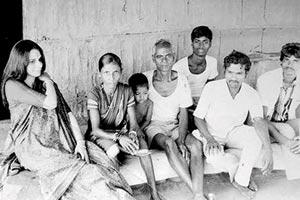Jivya Soma Mashe, who passed away this month, is credited not just as the artist who popularised Warli, but as the one who pioneered it as an art form. How did he make it relevant then and now?


Yashodhara Dalmia with Mashe and his family in the early 1980s. Pic/Maseeh Rahman
ADVERTISEMENT
When art historian and curator Yashodhara Dalmia first met Jivya Soma Mashe in the early 1980s, the Warli artist had just started working on paper instead of the walls on which his peers and ancestors had for generations. "I found it inventive, brave and fascinating," says Dalmia, who authored The Painted World of the Warlis: Art and Ritual of the Warli Tribes of Maharashtra in 1988.
Traditionally associated with the rituals and ceremonies of the Warli community, who reside in the Maharashtra-Gujarat border, the art form found new horizons through Mashe, who passed away on May 15 in Ganjad village, Palghar. He was 84. On his passing away, he was remembered as the artist who popularised the folk art form, rendering figures on paper smeared with cow-dung or a red background, and nudging Warli into mainstream visual culture.

Mashe's The Fish Bowl
Cultural theorist and curator Nancy Adajania says that it is a misconception that Mashe 'popularised' or 'preserved' Warli. "He did neither. He invented Warli art, as we know it today. He was a pioneer," she says. Before him, there was no "Warli art" as such. In its ritual form, it was practised in the Warli community by its women, not men, who would paint on the walls of their houses, a sacred square with the fertility goddess, surrounded by human and animal forms. "But Mashe wasn't consecrating the goddess in his paintings. He was a witness to his times, using the existing vocabulary of the ritual form and creating a new one," she says.
Cultural historian, prof Jyotindra Jain, who included Mashe in his seminal exhibition Other Masters: Five Contemporary Folk and Tribal Artists of India (1998), says the artist went far beyond the conventional themes of Warli, infusing the form with a narrative quality. "In 1998, Jivya produced an epic work comprising two large paintings on wooden boards entitled: My Life. This work relates to memory — memory of fragmentation and fear," he says.

(From left) Former gallerists Kekoo and Khorshed Gandhy with Mashe (centre) at his 1975 solo exhibition at Chemould Pic/ChemoulD Prescott Road archive
Jain's observation cuts through common misconceptions about Warli being a simplistic 'folksy' art. In My Life, a bipartite work, Jain observes that in one section, Mashe ruthlessly depicts a railway line cutting a village in two, dividing the fields, the river, the families, and the community. The second section depicts the memory of Jivya's first visit to this city, arriving at the Mumbai Central railway station filled with an ocean of people. "Despite the limited vocabulary of thin, linear humans of the Warli idiom, Jivya powerfully characterises each figure, be it a coolie carrying luggage, a policeman chasing a thief, or a monkey jumping on to a roof," he says.
In his paintings, we find signs of modernity — schools, railway junctions, as well as a depiction of the crafty moneylender, observes Adajania. His themes may find growing relevance now, as they did then, particularly through what Adajania describes as 'an environmental ethic' — an interdependence of human beings with other living things. Recalling one of his most famous and captivating works, Fisherman, she says, "A vast cosmic net held by a speck of a human being overpowers the painting. But this is not an expression of a competition with the powers of the divine; instead, Mashe is transmitting an ethic of empathetic coexistence among species, even as he asserts his own artistic agency."
The commercialisation of Warli art these days, says Adajania, is a symptom of a chronic problem faced by these artists. "They are susceptible to exploitation, because there are two unequal economies in our art world — one for the contemporary artist, the other for the so-called folk artist," she says. As a practice running parallel to other contemporary practices, as Mashe's did with the Bombay Progressives, there is the continuing need to give the art form the place it deserves. Dalmia, when she remembers that first meeting with Mashe, says he was living in poor circumstances. He would soon become the first from his community to find recognition, both Indian and international, as an artist.
Mentored by Bhaskar Kulkarni, a senior member of Crafts Board, Mashe had his first solo exhibition in 1975 at Kekoo and Khorshed Gandhy's Gallery Chemould. It was the first time that an exhibition of an artist from an indigenous community was held at a contemporary art gallery. When the gallery shifted in 2010, from Kala Ghoda to Fort, the gallerists decided to bid farewell by revisiting Mashe's works, instead of a group show of any of the other stellar Modernists. "He was not just an artist who transported the ritual tradition into a parallel contemporary form of art, but also a man of vision. He could foresee that this art would convey the daily life of his people and his own life," says Dalmia.
Catch up on all the latest Mumbai news, crime news, current affairs, and also a complete guide on Mumbai from food to things to do and events across the city here. Also download the new mid-day Android and iOS apps to get latest updates
 Subscribe today by clicking the link and stay updated with the latest news!" Click here!
Subscribe today by clicking the link and stay updated with the latest news!" Click here!






